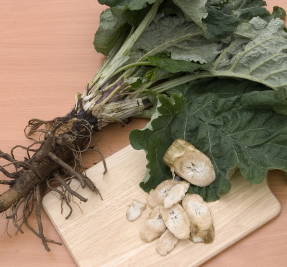Burdock and plantain, despite their medicinal properties, are considered by most Russian gardeners to be weeds. Recently, however, they have been ranked among vegetable crops, which, however, still have to win their place in the garden. By the way, in some countries these vegetable plants have been known for a long time and are valued for their taste and nutritional properties.
Big burdock, in Japanese - gobo

Burdock (Arctium lappa) it is officially considered a vegetable crop in Japan and is widely distributed in this capacity. The Japanese call it "gobo" and willingly eat not only roots, but also young leaves and petioles. Juicy and fleshy petioles are used in soups and salads, and a special burdock flour is made from the roots. In Japan, there are many varieties of vegetable burdock, and recently the first Russian late-ripening variety, the Samurai, has appeared.
Burdock belongs to the family of Asteraceae, or Asteraceae. In the first year, a semi-raised rosette of leaves develops - large, ovoid, with slightly wavy edges and slight wrinkling, grayish-green, in the second in the center of the rosette there is a peduncle with baskets of purple-violet inflorescences. The root crop acquires marketable ripeness in 75-80 days from the moment of germination. In appearance, it resembles a large carrot. With proper care, the root crop can grow up to 35 cm long, up to 5 cm wide in diameter, and gain weight up to 600 g. The pulp of burdock root crops is grayish-white, juicy, sweetish, and has a pleasant taste.
Gobo leaves are pubescent, so before use they are scalded with boiling water and strongly crushed. The petioles are cleaned of hard integument, finely chopped and used for making soups, scrambled eggs, omelet.
Useful properties of burdock
Burdock greens are rich in vitamins and minerals as well as fiber. Vegetable burdock leaves are used to treat bruises, sprains, rheumatism. The roots have a choleretic and diuretic effect, increase the release of insulin, which regulates blood sugar levels. In addition, burdock roots contain biologically active substances, organic acids, oils that prevent fat deposition. Burdock oil is prepared from them, which has long been used to strengthen hair.

Growing burdock
Growing a vegetable burdock on your site is not difficult. Seeds are sown in the spring directly into the ground to a depth of 1-2 cm. It is undesirable to grow through seedlings or transplant young plants, since during transplantation, root crops branch out strongly. Planting scheme with fresh seeds - 40x60 cm. Sowing time - April-May. You can sow burdock before winter - at the end of October. Ridges for growing burdock must be dug very deep, the earth must be loose and preferably light. For digging, organic fertilizers (compost, humus) are applied, fresh manure is not recommended, since the plant grows a large leaf mass to the detriment of root crops. If the soil is heavy, it is recommended to add loosening agents (sawdust, sand, etc.). When applying fertilizers, special attention should be paid to potash - root crops need it most of all. Until emergence, the soil is kept moist. Until the leaves reach a height of about 20 cm, the garden is weeded, and then the plant itself suppresses the weeds.
Root crops are dug up in mid-October. You can leave some of the plants until spring, in this case, you need to harvest before the flower stalks protrude, no later than mid-June. Several root vegetables can be left for seeds if there are no wild relatives nearby.
What can be cooked from burdock
Korean burdock, Spring salad, Burdock leaves in batter
Plantain, but not big
Deer-horned plantain, or pinnate (Plantago coronopus) from the plantain family (Plantaginaceae) widespread in Western Europe and the Mediterranean.In the wild, it grows along sea coasts, on rocky and sandy places, less often on saline soils far from the coast. The deer-horned plantain is not at all similar to our usual ubiquitous large plantain. It is a perennial herb, which can be annual or biennial, depending on the region of cultivation, with a rosette of basal leaves and numerous arcuate ascending flowering stems, reaching a height of 25 cm.Numerous leaves 4-8 cm long, deeply pinnately incised, pointed at the apex , absent-mindedly pubescent. Small inconspicuous flowers are collected in dense spike-shaped inflorescences 3-8 cm long.

The first Russian cultivar of the deer-horned plantain Bambi is a new valuable salad crop for growing in the open field. The rosette of leaves of the plantain variety Bambi is semi-raised, well leafy. The average diameter of the rosette is 15 cm, the height is 20 cm. The lanceolate leaf blade with processes. The average length of a leaf is 14 cm, width is 0.8 cm. The color of the leaves is green. The surface of the sheet is smooth. Average yield - 1.5 kg / m2.
Useful properties of plantain
Plantain leaves contain carotene, vitamins C and K, citric acid, phytoncides, enzymes, aucubin glycoside, tannins. Plantain seeds contain saponins, oleic acid, and carbohydrates.
Young and tender plantain leaves are widely used for making salads with onions, potatoes, nettles. Plantain is added to many dishes such as cabbage soup, omelets, casseroles, mashed potatoes and cutlets.
Growing plantain
Plantain can be grown via seedlings and direct sowing in the spring. The seeds give very friendly shoots, which must be thinned out, leaving a distance of 10 cm between the plants. Plantain is unpretentious. Care consists of timely watering and regular weeding. When grown in partial shade, the leaves are more tender. The greens are harvested in three months. The plant can withstand small spring and autumn frosts, but does not overwinter in the conditions of the Moscow region.
Plantain recipes
Cutlets from plantain leaves, Salad from plantain with onions, Green cabbage soup from plantain, Plantain leaves baked with milk.









